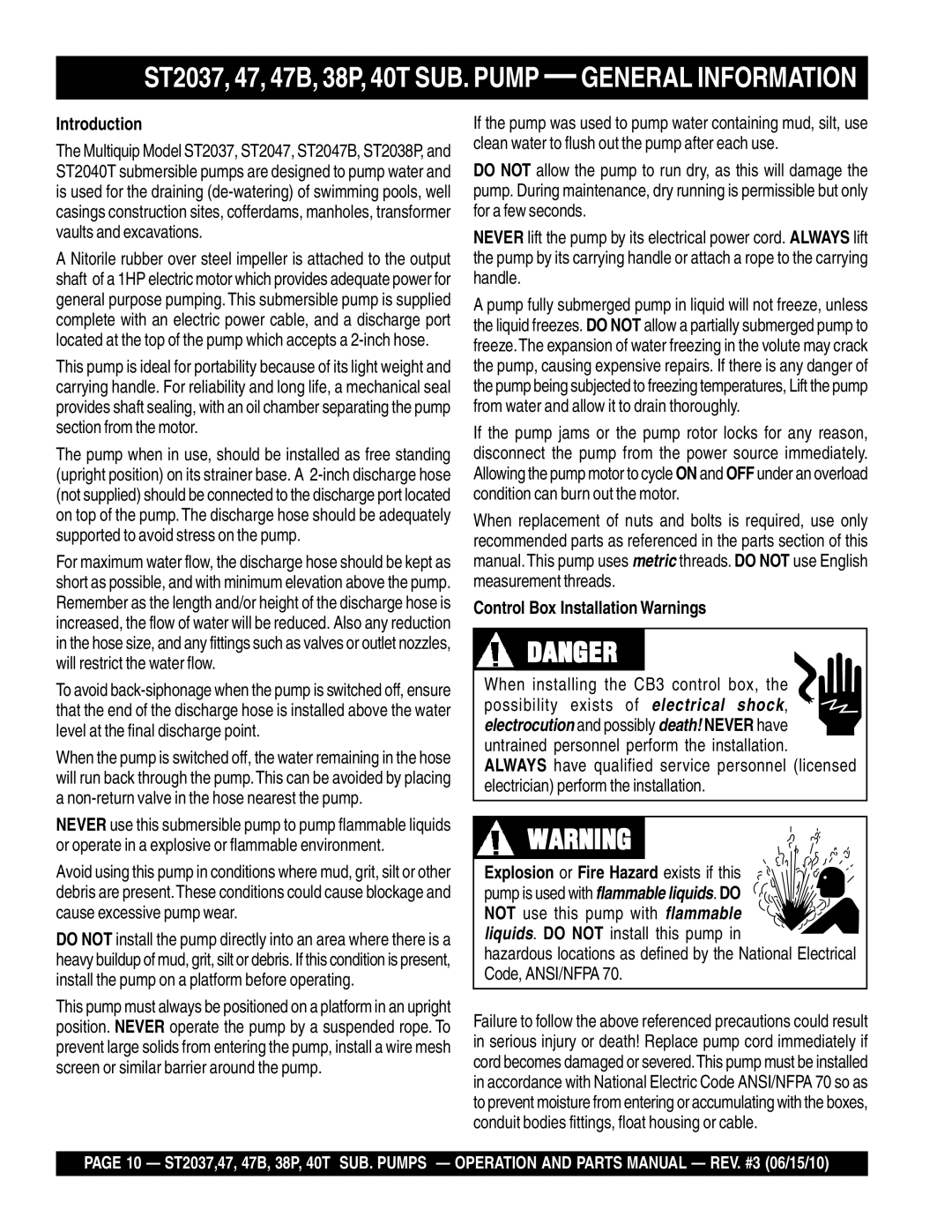
ST2037, 47, 47B, 38P, 40T SUB. PUMP — GENERAL INFORMATION
Introduction
The Multiquip Model ST2037, ST2047, ST2047B, ST2038P, and ST2040T submersible pumps are designed to pump water and is used for the draining
A Nitorile rubber over steel impeller is attached to the output shaft of a 1HP electric motor which provides adequate power for general purpose pumping. This submersible pump is supplied complete with an electric power cable, and a discharge port located at the top of the pump which accepts a
This pump is ideal for portability because of its light weight and carrying handle. For reliability and long life, a mechanical seal provides shaft sealing, with an oil chamber separating the pump section from the motor.
The pump when in use, should be installed as free standing (upright position) on its strainer base. A
For maximum water flow, the discharge hose should be kept as short as possible, and with minimum elevation above the pump. Remember as the length and/or height of the discharge hose is increased, the flow of water will be reduced. Also any reduction in the hose size, and any fittings such as valves or outlet nozzles, will restrict the water flow.
To avoid
When the pump is switched off, the water remaining in the hose will run back through the pump.This can be avoided by placing a
NEVER use this submersible pump to pump flammable liquids or operate in a explosive or flammable environment.
Avoid using this pump in conditions where mud, grit, silt or other debris are present.These conditions could cause blockage and cause excessive pump wear.
DO NOT install the pump directly into an area where there is a heavy buildup of mud, grit, silt or debris. If this condition is present, install the pump on a platform before operating.
This pump must always be positioned on a platform in an upright position. NEVER operate the pump by a suspended rope. To prevent large solids from entering the pump, install a wire mesh screen or similar barrier around the pump.
If the pump was used to pump water containing mud, silt, use clean water to flush out the pump after each use.
DO NOT allow the pump to run dry, as this will damage the pump. During maintenance, dry running is permissible but only for a few seconds.
NEVER lift the pump by its electrical power cord. ALWAYS lift the pump by its carrying handle or attach a rope to the carrying handle.
A pump fully submerged pump in liquid will not freeze, unless the liquid freezes. DO NOT allow a partially submerged pump to freeze.The expansion of water freezing in the volute may crack the pump, causing expensive repairs. If there is any danger of the pump being subjected to freezing temperatures, Lift the pump from water and allow it to drain thoroughly.
If the pump jams or the pump rotor locks for any reason, disconnect the pump from the power source immediately. Allowing the pump motor to cycle ON and OFF under an overload condition can burn out the motor.
When replacement of nuts and bolts is required, use only recommended parts as referenced in the parts section of this manual.This pump uses metric threads. DO NOT use English measurement threads.
Control Box Installation Warnings
![]() DANGER
DANGER
When installing the CB3 control box, the possibility exists of electrical shock, ![]()
![]()
![]() electrocution and possibly death! NEVER have untrained personnel perform the installation. ALWAYS have qualified service personnel (licensed electrician) perform the installation.
electrocution and possibly death! NEVER have untrained personnel perform the installation. ALWAYS have qualified service personnel (licensed electrician) perform the installation.
![]() WARNING
WARNING
Explosion or Fire Hazard exists if this ![]()
![]()
![]()
![]()
![]()
![]()
![]() pump is used with flammable liquids. DO
pump is used with flammable liquids. DO ![]()
![]()
![]()
![]()
![]()
![]()
![]() NOT use this pump with flammable
NOT use this pump with flammable ![]()
![]()
![]()
![]()
![]() liquids. DO NOT install this pump in
liquids. DO NOT install this pump in ![]() hazardous locations as defined by the National Electrical Code, ANSI/NFPA 70.
hazardous locations as defined by the National Electrical Code, ANSI/NFPA 70.
Failure to follow the above referenced precautions could result in serious injury or death! Replace pump cord immediately if cord becomes damaged or severed.This pump must be installed in accordance with National Electric Code ANSI/NFPA 70 so as to prevent moisture from entering or accumulating with the boxes, conduit bodies fittings, float housing or cable.
PAGE 10 — ST2037,47, 47B, 38P, 40T SUB. PUMPS — OPERATION AND PARTS MANUAL — REV. #3 (06/15/10)
